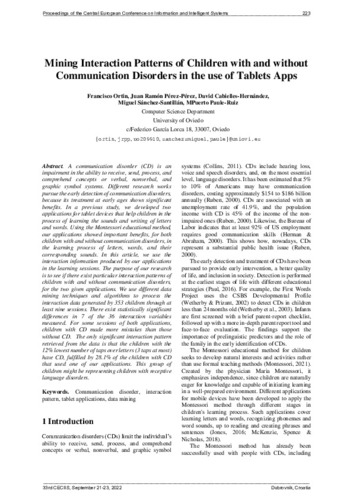Mining Interaction Patterns of Children with and without Communication Disorders in the use of Tablets Apps
Palabra(s) clave:
Interaction pattern
Communication disorder
Tablet applications
Data mining
Fecha de publicación:
Descripción física:
Resumen:
A communication disorder (CD) is an impairment in the ability to receive, send, process, and comprehend concepts or verbal, nonverbal, and graphic symbol systems. Different research works pursue the early detection of communication disorders, because its treatment at early ages shows significant benefits. In a previous study, we developed two applications for tablet devices that help children in the process of learning the sounds and writing of letters and words. Using the Montessori educational method, our applications showed important benefits, for both children with and without communication disorders, in the learning process of letters, words, and their corresponding sounds. In this article, we use the interaction information produced by our applications in the learning sessions. The purpose of our research is to see if there exist particular interaction patterns of children with and without communication disorders, for the two given applications. We use different data mining techniques and algorithms to process the interaction data generated by 353 children through at least nine sessions. There exist statistically significant differences in 7 of the 36 interaction variables measured. For some sessions of both applications, children with CD made more mistakes than those without CD. The only significant interaction pattern retrieved from the data is that the children with the 12% lowest number of taps over letters (3 taps at most) have CD, fulfilled by 28.1% of the children with CD that used one of our applications. This group of children might be representing children with receptive language disorders.
A communication disorder (CD) is an impairment in the ability to receive, send, process, and comprehend concepts or verbal, nonverbal, and graphic symbol systems. Different research works pursue the early detection of communication disorders, because its treatment at early ages shows significant benefits. In a previous study, we developed two applications for tablet devices that help children in the process of learning the sounds and writing of letters and words. Using the Montessori educational method, our applications showed important benefits, for both children with and without communication disorders, in the learning process of letters, words, and their corresponding sounds. In this article, we use the interaction information produced by our applications in the learning sessions. The purpose of our research is to see if there exist particular interaction patterns of children with and without communication disorders, for the two given applications. We use different data mining techniques and algorithms to process the interaction data generated by 353 children through at least nine sessions. There exist statistically significant differences in 7 of the 36 interaction variables measured. For some sessions of both applications, children with CD made more mistakes than those without CD. The only significant interaction pattern retrieved from the data is that the children with the 12% lowest number of taps over letters (3 taps at most) have CD, fulfilled by 28.1% of the children with CD that used one of our applications. This group of children might be representing children with receptive language disorders.
Descripción:
Central European Conference on Information and Intelligent Systems (CECIIS) (33rd. 2022. Dubrovnik, Croatia)
ISSN:
Patrocinado por:
This work has been partially funded by the Department of Science, Innovation and Universities: project RTI2018- 099235-B-I00. We have also received funds from the Principality of Asturias, through its Science, Technology and Innovation Plan (FC-GRUPIN- IDI/2018/000199) and University of Oviedo (GR-2011-0040).
Colecciones
- Informática [875]
- Investigaciones y Documentos OpenAIRE [8420]
- Ponencias, Discursos y Conferencias [4233]
Ficheros en el ítem





